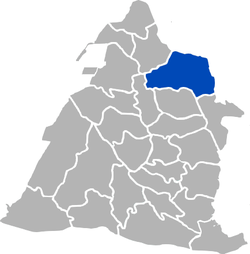Changhua City
| Changhua 彰化 | |
|---|---|
| County-controlled city | |
| Changhua City · 彰化市 | |
 | |
| Nickname(s): Bamboo Town (Chinese: 半線城) | |
 | |
| Country |
|
| County | Changhua County |
| Government | |
| • Mayor | Qiu Jianfu () |
| Area | |
| • Total | 65.68 km2 (25.36 sq mi) |
| Population (2012) | |
| • Total | 236,588 |
| Website | www.changhua.gov.tw |


Changhua, officially known as Changhua City (Chinese: 彰化市; pinyin: Zhānghuà Shì; Wade–Giles: Chang-hua Shih; Pe̍h-ōe-jī: Chiong-hòa-Chhī), is a city and the county seat of Changhua County in Taiwan. For many centuries the site was home to a settlement of Babuza people, a coastal tribe of Taiwanese aborigines. The name of the city is derived from the aboriginal word Poasoa (Han characters: 半線; Taiwanese: Pòaⁿ-sòaⁿ). Changhua city is ranked third by population as county-controlled city only after Taoyuan City and Zhongli City. Historically, Changhua city was a base for the Hans when they invaded Taiwan and to defend from the Taiwanese aboriginese, a fortress built out of bamboo was made. Thus Changhua has earned its name as "Bamboo Town".
Changhua is best known for its landmark statue of the Buddha. At 26 metres tall, the statue sits atop Bagua Mountain overlooking the city. The main walkway up to the giant is lined with statues of figures from Buddhist lore. Another site of interest is Taiwan's oldest temple honoring Confucius.
History
Changhua (Changhwa) city was once a center of settlement for the Plains Aborigines and the Babuza people both of which are tribes of the Taiwanese aboriginals. During the Dutch period, Changhua city belonged to the Walbulan administration and was controlled by the Dutch East India Company of the Formosa division. During Zheng's invasion to Taiwan from Mainland China, Changhua city was also one of the central defense and attack bases. During the Chinese immigration of the 17th century, Changhua city was one of the four cities that had major immigration, thus it was one of the oldest settlements by the Hans.
During the late 17th to late 19th century Changhua continued to be one of the major urban settlements in Central Taiwan. Changhua had thus earned itself an independent Changhua County. Despite that there were rebels and ongoing civil wars.
The origin of today's Changhua city was attributed to the Japanese organizing Taiwan's land, the Japanese turned Changhua city to an official county seat of the Changhua county in 1897.
Geography
Changhua city has plenty of flat lands, however, the flat lands are divided in two portions by the Central Mountain Range of Taiwan. One on the South Eastern area and the other on the North Western area. The North Eastern area, although being flat, is often affected by soil erosion caused by typhoons during the summer, thus is not suitable for living.
The temperature of Changhua city on average is 22.4°C, annually, with July being the hottest and January being the coolest. Annual rainfall is 1723.4 mm, June being the wettest and November being the driest. Rainfall decreases westward closer to the coastline.
Economy
Changhua city is one of the more developed areas of Changhua county, from 1970 a trend of industrialization has been ongoing. This is reflected by an increase of factories in Changhua and decreasing amount of agricultural fields. However, Changhua city has a considerable amount of pollution as a result of this industrialization. From a poll in 1992, 43.2% of respondents work in the servicing sector, 42.4% works in industrial sector and only 14.4% works either in agricultural or the fishing sector. The local Changhua city government has a plan to expand the city from the current 12.35 km2 to 22.61 km2 with the hope to boost the standard of living as well.
Education
Due to Changhua city's urban nature it owns more educational resources allocated by the local government compared to neighboring townships or cities of Changhua county. The earliest school in Changhua dates back to 1726 during the Qing dynasty. In addition, the Japanese also improved the education system in Changhua city during World War II. As of the time this is written, Changhua city owns 15 elementary schools, 7 junior high schools, 7 senior high schools and 2 technical/universities.
Changhua City Library.[1]
Universities
Tourist attractions
- Anti-Japanese Martyrs' Monument Park
- Baguashan Great Buddha
- Changhua Arts Museum
- Changhua Nanyao Temple Cultural Hall
- Fan-shaped Roundhouse
- Gu-Yue Folk Museum
- Huayang Park
- Hsinding Old Street
- Lai Ho Memorial Hall
- Literature Walk
- Museum of Traditional Nan Bei Music and Theater
- Natural Ecology Garden
- Red Hair Well
- Silver Bridge
- Yuan Ching Kaun Tradition Art Museum
Transportation
Changhua Station is currently the only Taiwan Railway Administration in Changhua city.
National Highway 1 connects Changhua city to Taichung city and this is one of the primary route for commuters between Changhua city and Taichung city as well.
National Highway 1 intersects with National Highway 3 at Changhua and connects to Provincial Highway 74.
Others
On 25 May 2002 China Airlines Flight 611 broke into pieces in mid-air. Parts of the plane landed in Changhua.[4][5]
See also
References
External links
- Changhua City Government Website
- Changhua City Government Website (Chinese)
- National Changhua University of Education
- National Changhua University of Education (Chinese)
- Chienkuo Technology University
- Chienkuo Technology University (Chinese)
| |||||||||||||||||
Coordinates: 24°04′N 120°32′E / 24.067°N 120.533°E

